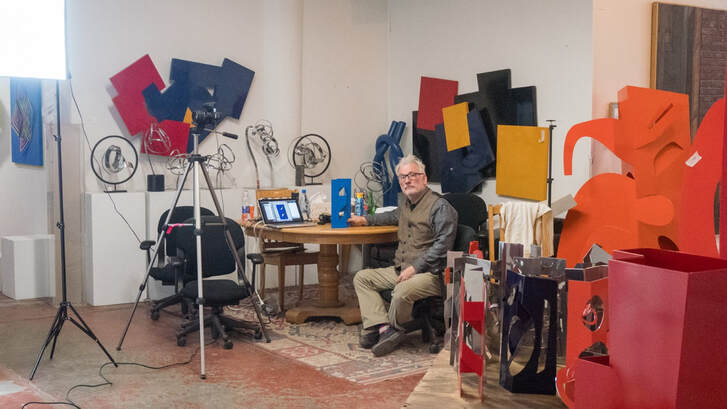Dan Droz
Themes. What are the themes and/or threads that connect your body of work?
“What is essential is invisible to the eye.” The Little Prince/ Antoine de Saint-Exupery
What we’re seeing is only part of the story and can even be illusory – camouflaging or misdirecting our attention away from important underlying information. As a teenager, I was interested in magic, which has two simultaneous realities: what observers see and what is ‘really’ going on. Sculpture deals with similar issues. Suspension has qualities of levitation. Reflection and use of mirrors can warp one’s sense of how a space is configured. And certainly, what’s underneath or behind your viewing plane suggests that something important lurks behind the curtain. Metaphorically, the fact that our perceptions of reality are limited, underscores the central challenge of art – changing the way we experience reality without completely abandoning it.
Process and Formal Language. What materials, processes and forms do you use?
I work primarily with metal sheets and extrusions, folding planes and transforming lines, without adding or subtracting any material. Metaphorically, this references our ability to transform ourselves and our world within powerful constraints, without substantially changing the core of ‘who we are.’
Subjects, Narrative and Meaning. What are you trying to express?
My sculpture deals with the intertwining relationships/connections between each other and the material world. For example, connecting with others requires an understanding and appreciation of ideas and motivations different from our own. How can we understand/appreciate/adapt to different ideas and circumstances? By seeing beyond the obvious.
Impact. Where do you want to go with your art?
I’m interested in making large scale sculpture that can enhance public spaces and create a ‘common ground’ for people. Sculpture in public settings can elevate architecture and enhance placemaking by adding meaning and connection.
“What is essential is invisible to the eye.” The Little Prince/ Antoine de Saint-Exupery
What we’re seeing is only part of the story and can even be illusory – camouflaging or misdirecting our attention away from important underlying information. As a teenager, I was interested in magic, which has two simultaneous realities: what observers see and what is ‘really’ going on. Sculpture deals with similar issues. Suspension has qualities of levitation. Reflection and use of mirrors can warp one’s sense of how a space is configured. And certainly, what’s underneath or behind your viewing plane suggests that something important lurks behind the curtain. Metaphorically, the fact that our perceptions of reality are limited, underscores the central challenge of art – changing the way we experience reality without completely abandoning it.
Process and Formal Language. What materials, processes and forms do you use?
I work primarily with metal sheets and extrusions, folding planes and transforming lines, without adding or subtracting any material. Metaphorically, this references our ability to transform ourselves and our world within powerful constraints, without substantially changing the core of ‘who we are.’
Subjects, Narrative and Meaning. What are you trying to express?
My sculpture deals with the intertwining relationships/connections between each other and the material world. For example, connecting with others requires an understanding and appreciation of ideas and motivations different from our own. How can we understand/appreciate/adapt to different ideas and circumstances? By seeing beyond the obvious.
Impact. Where do you want to go with your art?
I’m interested in making large scale sculpture that can enhance public spaces and create a ‘common ground’ for people. Sculpture in public settings can elevate architecture and enhance placemaking by adding meaning and connection.
Biography
Dan Droz’s large-scale freestanding and wall-mounted works incorporate folds, reflection and artificial glows to draw attention to the limits of perception, developing novel methods for forming metal, glass and wire mesh. His work has been included in numerous solo and juried exhibitions including the Westmoreland Museum of Art, Associated-Artists-of-Pittsburgh, James Gallery, the Pittsburgh International Airport and commissions for public, commercial and private collections including the Museum of Art and History/Los Angeles and The Visions project at the entrance to the Heritage Trail in Pittsburgh,
For 17 years, Droz taught at CMU in both the College-of-Fine-Arts and Business School.
Droz graduated cum laude from Harvard College in 1972 and in 1996, was recognized as a “Distinguished Design Alumni.”
For 17 years, Droz taught at CMU in both the College-of-Fine-Arts and Business School.
Droz graduated cum laude from Harvard College in 1972 and in 1996, was recognized as a “Distinguished Design Alumni.”

